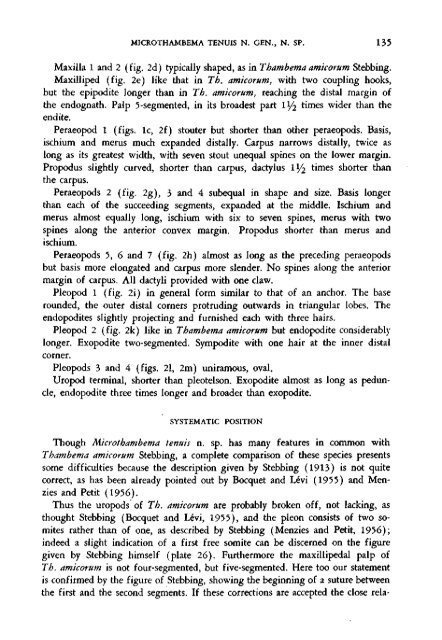MICROTHAMBEMA TENUIS N. GEN., N. SP. (ISOPODA ASELLOTA ...
MICROTHAMBEMA TENUIS N. GEN., N. SP. (ISOPODA ASELLOTA ...
MICROTHAMBEMA TENUIS N. GEN., N. SP. (ISOPODA ASELLOTA ...
Create successful ePaper yourself
Turn your PDF publications into a flip-book with our unique Google optimized e-Paper software.
<strong>MICROTHAMBEMA</strong> <strong>TENUIS</strong> N. <strong>GEN</strong>., N. ST. 135<br />
Maxilla 1 and 2 (fig. 2d) typically shaped, as in Thambema amicorum Stebbing.<br />
Maxilliped (fig. 2e) like that in Tb. amicorum, with two coupling hooks,<br />
but the epipodite longer than in Th. amicorum, reaching the distal margin of<br />
the endognath. Palp 5-segmented, in its broadest part 1^ times wider than the<br />
endite.<br />
Peraeopod 1 (figs, lc, 2f) stouter but shorter than other peraeopods. Basis,<br />
ischium and merus much expanded distally. Carpus narrows distally, twice as<br />
long as its greatest width, with seven stout unequal spines on the lower margin.<br />
Propodus slightly curved, shorter than carpus, dactylus iy 2 times shorter than<br />
the carpus.<br />
Peraeopods 2 (fig. 2g), 3 and 4 subequal in shape and size. Basis longer<br />
than each of the succeeding segments, expanded at the middle. Ischium and<br />
merus almost equally long, ischium with six to seven spines, merus with two<br />
spines along the anterior convex margin. Propodus shorter than merus and<br />
ischium.<br />
Peraeopods 5, 6 and 7 (fig, 2h) almost as long as the preceding peraeopods<br />
but basis more elongated and carpus more slender. No spines along the anterior<br />
margin of carpus. All dactyli provided with one claw.<br />
Pleopod 1 (fig. 2i) in general form similar to that of an anchor. The base<br />
rounded, the outer distal corners protruding outwards in triangular lobes. The<br />
endopodites slightly projecting and furnished each with three hairs.<br />
Pleopod 2 (fig. 2k) like in Thambema amicorum but endopodite considerably<br />
longer, Exopodite two-segmented. Sympodite with one hair at the inner distal<br />
corner.<br />
Pleopods 3 and 4 (figs. 21, 2m) uniramous, oval.<br />
Uropod terminal, shorter than pleotelson. Exopodite almost as long as peduncle,<br />
endopodite three times longer and broader than exopodite.<br />
SYSTEMATIC POSITION<br />
Though Microtbambema tenuis n. sp. has many features in common with<br />
Thambema amicorum Stebbing, a complete comparison of these species presents<br />
some difficulties because the description given by Stebbing (1913) is not quite<br />
correct, as has been already pointed out by Bocquet and Levi (1955) and Menzies<br />
and Petit (1956).<br />
Thus the uropods of Th. amicorum are probably broken off, not lacking, as<br />
thought Stebbing (Bocquet and Levi, 1955), and the pleon consists of two somites<br />
rather than of one, as described by Stebbing (Menzies and Petit, 1956);<br />
indeed a slight indication of a first free somite can be discerned on the figure<br />
given by Stebbing himself (plate 26), Furthermore the maxillipedal palp of<br />
Tb. amicorum is not four-segmented, but five-segmented. Here too our statement<br />
is confirmed by the figure of Stebbing, showing the beginning of a suture between<br />
the first and the second segments. If these corrections are accepted the close rela-
















